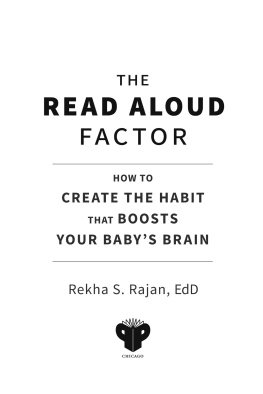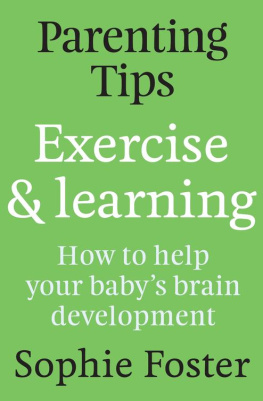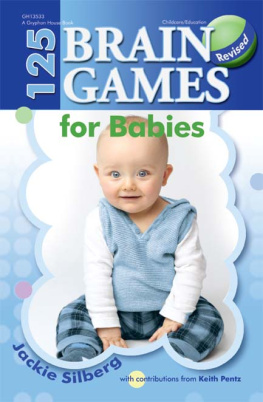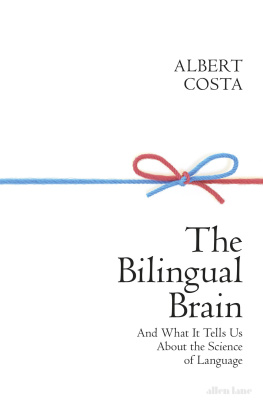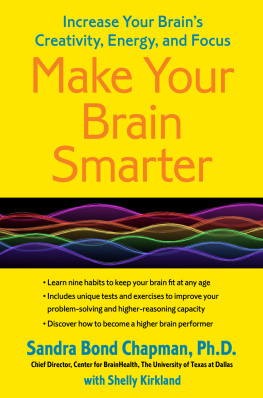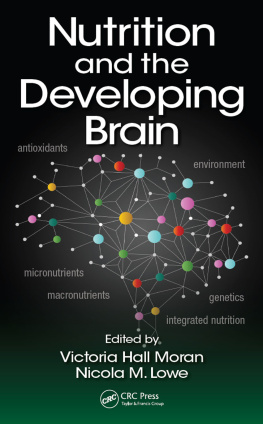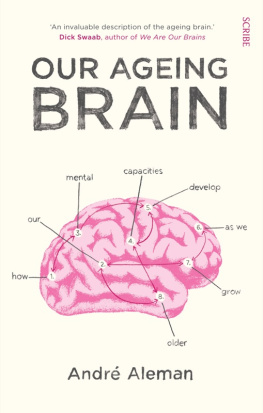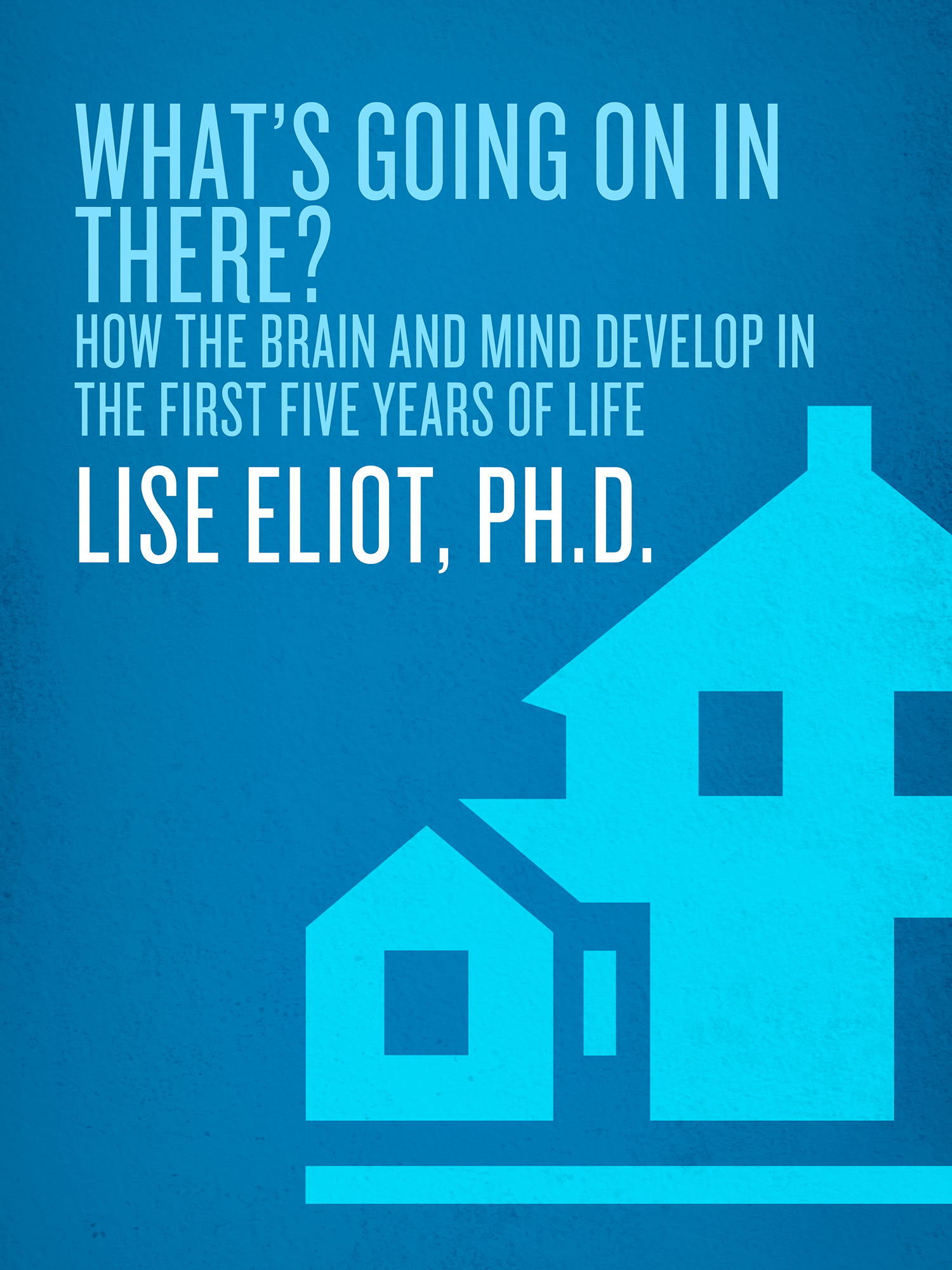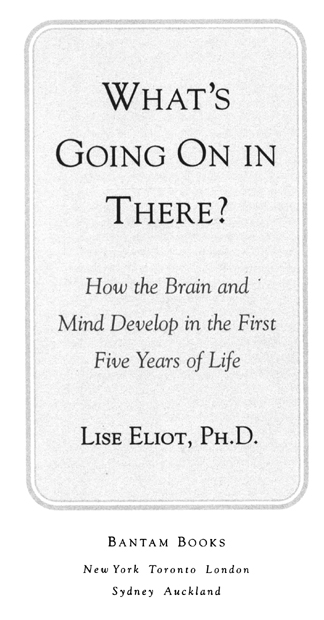Critical praise for Lise Eliots
W HATS G OING O N IN T HERE ?
With impressive depth and clarity, Eliot offers a comprehensive overview of current scientific knowledge about infant and early childhood brain development. [She] presents research results on almost every conceivable topic of interest to the curious parent. [Her] confidence in the open-minded interest of her readers makes this a good bet for scientifically oriented parents who want to grasp how a childs mind develops. All in all, this is popular science at its best.
Publishers Weekly (starred review)
Readable and informative Eliot, a neurobiologist, doesnt let dry science dominate her writingafter all, she has children herselfbut the information she provides is based on science, not just morality. Parents, prospective parents, friends, and teachers all stand to learn from Eliots well-thought-out effort.
Booklist
[Eliots] prose is generally quite graceful, and her neuroscience-based advice to parents sometimes bucks current trends. [She] explains, among other things, why young children crave sweets and fats, why preschoolers cant control themselves, how male and female brains differ, and how a simple marshmallow test can help predict later achievement.
Kirkus Reviews
Immensely readable study of how the brain develops from conception to age five. This book is both theoretical and practical, combining scientific reportage with how-to advice for new parents. With clear, mostly simple language, she guides readers through a fascinating array of new research. A real page-turner; highly recommended.
Library Journal
This is the perfect book for parents. Although its written by a neurobiologist whos also the mother of three, its not terribly technical and entertains with its descriptions of real babies. A terrific book. Expectant parents might consider reading it before the baby arrives.
Los Angeles Times
This edition contains the complete text of the original hardcover edition.
NOT ONE WORD HAS BEEN OMITTED .

W HATS G OING O N IN T HERE ?
A Bantam Book
PUBLISHING HISTORY
Bantam hardcover edition published 1999
Bantam trade paperback edition / October 2000
All rights reserved.
Copyright 1999 by Lise Eliot, Ph.D.
Illustrations on by Deborah Rubenstein.
Library of Congress Catalog Card Number: 99-35423
No part of this book may be reproduced or transmitted in any form or by any means, electronic or mechanical, including photocopying, recording, or by any information storage and retrieval system, without permission in writing from the publisher.
For information address: Bantam Books.
eISBN: 978-0-307-57538-8
Bantam Books are published by Bantam Books, a division of Random House, Inc. Its trademark, consisting of the words Bantam Books and the portrayal of a rooster, is Registered in U.S. Patent and Trademark Office and in other countries. Marca Registrada. Bantam Books, New York, New York.
v3.1_r2
C ONTENTS
Chapter 1
N ATURE OR N URTURE ? I TS A LL IN THE B RAIN
Chapter 2
T HE B ASIC B IOLOGY OF B RAIN D EVELOPMENT
Chapter 3
P RENATAL I NFLUENCES ON THE D EVELOPING B RAIN
Chapter 4
H OW B IRTH A FFECTS THE B RAIN
Chapter 5
T HE I MPORTANCE OF T OUCH
Chapter 6
W HY B ABIES L OVE TO B E B OUNCED : T HE P RECOCIOUS S ENSE OF B ALANCE AND M OTION
Chapter 7
T HE E ARLY W ORLD OF S MELL
Chapter 8
T ASTE , M ILK, AND THE O RIGINS OF F OOD P REFERENCE
Chapter 9
W IRING U P THE V ISUAL B RAIN
Chapter 10
H OW H EARING E VOLVES
Chapter 11
M OTOR M ILESTONES
Chapter 12
S OCIAL -E MOTIONAL G ROWTH
Chapter 13
T HE E MERGENCE OF M EMORY
Chapter 14
L ANGUAGE AND THE D EVELOPING B RAIN
Chapter 15
H OW I NTELLIGENCE G ROWS IN THE B RAIN
Chapter 16
N ATURE , N URTURE, AND S EX D IFFERENCES IN I NTELLECTUAL D EVELOPMENT
Chapter 17
H OW TO R AISE A S MARTER C HILD
Chapter 1

N ATURE OR N URTURE ? I TS A LL IN THE B RAIN
Wouldnt you know it? Just as I get this beautiful, healthy neuron filled with dye and ready to image, Julia wakes up and starts crying. The experiment takes a long time to set up; Ive been at it most of the day and need just ten more uninterrupted minutes. She has been so cooperativesleeping like a baby (a nine-week-old, to be exact) in her cozy, blanket-lined computer box, safe and secure near my desk in the darkened laboratory. Finally, all the conditions are right: the microscopic neuron, vividly fluorescing down to its tiniest branches, an electrode carefully implanted to measure its electrical activity. Im about to stimulate the cells input pathway, to test whether it will learn from simulated sensory experiencewhen of course, Julia wakes up and wants to be fed.
What the heck. I pick her up, hike up my shirt, and start nursing, all the while twiddling dials with my free left hand. Take off the holding current, I tell myself. Set the extracellular voltage, configure the data acquisition, and then go! The pulse goes out, the neuron fires a lovely train of electrical potentials, and the cell fills with calcium, color-coded, on the computer screen, with red for the most intense spots, yellow in between, and blue for the cold spotsdistant branches that dont seem to have many pores for calcium to flow in. Its a great cell, an almost ideal experiment, until Julia suddenly pulls off my breast (curious, no doubt, about the flash of light on the computer screen) and, kicking her right foot into the delicate micromanipulator, knocks my perfect electrode right out of the perfect cell.
No! I wail, staring in disbelief at the computer screen. I watch as the neuron blows up into a big balloon, its membranes ripped open by the moving electrode. As it ruptures, the image on the computer screen flashes to red, then fades to orange, yellow, green, and blue as the dye dissipates. The cell is dead, a quick demise that is painful only for me.
Nobody ever said it would be easy being a mother and neuroscientist. But the juxtaposition does have its rewards at times. Here I am, trying to figure out how the neurons in a young rats brain change with experience, and I have my own little experiment brewing right under my nose. Annoyed as I am by Julias gymnastics, who can blame her baby brain, just trying to get some exercise for its budding motor pathways? Everything Im trying to study in young rats is going on in her small head, a billion times over, every second of every day.




